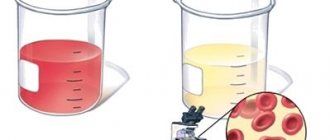Chronic sinusitis is a long-term (more than 3 months) inflammation in the maxillary (maxillary) sinus. In most cases, it is a consequence of a protracted and complicated acute process, but primary chronic forms of the disease also occur.
Most often, chronic sinusitis has an undulating course, with periods of exacerbation and subsidence (remission). Less commonly diagnosed is a continuously ongoing form of the disease, with an almost constant presence of symptoms. And sometimes the process occurs without obvious external manifestations and becomes an accidental diagnostic finding.
What happens in the sinus?
Chronic sinusitis is predisposed to:
- inadequate treatment of acute inflammation, with self-medication and non-compliance with medical recommendations;
- the presence of anatomical features that complicate drainage of the maxillary sinus - curvature of the nasal septum, deformation of the turbinates and the presence of neoplasms that impair ventilation and drainage of the maxillary sinus;
- the presence of concomitant pathology of the ENT organs, such as allergic rhinitis, hay fever.
The transition of inflammation to the chronic phase is characterized by structural changes in the mucous membrane. Swelling with serous-mucous discharge, characteristic of acute sinusitis, persists. As a result, a complex of productive-exudative disorders occurs in the affected sinus, which support infectious inflammation and are usually not able to resolve on their own.
Over time, deep-lying tissues and neighboring anatomical structures are involved in the process, and complications develop. A chronic infection in the sinus weakens the responsiveness of the immune system, making a person susceptible to upper respiratory tract infections.
Causes and course of the disease
Maxillary sinusitis occurs:
- catarrhal;
- purulent;
- parietal-hyperplastic;
- polyposis;
- fibrous;
- cystic;
- allergic.
The causative agent of the disease is coccal flora, most often streptococcus. Recently, fungal microflora, anaerobes, and viruses have begun to act as pathogens. An increase in various types of aggressive associations is also noted, which increase the degree of pathogenicity of pathogens. Due to the transition of the inflammatory process to a chronic form, obstruction (closure) of the outlet (ostium) occurs and the drainage and ventilation function is disrupted, which leads to the accumulation of exudate and the inflammatory process worsens.
The development of the disease is promoted by:
- deformation of the nasal septum;
- synechia (pathological adhesions in the nasal cavity);
- adenoids;
- aggression of pathogenic microorganisms, as well as the formation of their associations.
The following factors predispose to the development of this disease:
- incomplete cure of acute rhinitis;
- allergy;
- decreased local and general immunity;
- disruption of microcirculation of the mucous membrane and permeability of blood vessels and tissues.
Manifestations of chronic maxillary sinusitis
In most cases, patients with chronic sinusitis complain of a lingering runny nose. Characterized by one- or two-sided nasal congestion, a significant deterioration in the sense of smell and the presence of mucous or mucopurulent discharge, especially in the morning.
Exacerbation of chronic sinusitis is accompanied by an increase in existing symptoms. Body temperature rises, intoxication, a feeling of heaviness and pain in the infraorbital and paranasal region occur. The discharge becomes more abundant and purulent. They flow down the back of the throat, causing coughing at night.
When inflammation spreads to the tissue of the orbit, swelling of the lower eyelid and infraorbital region and pain when moving the eyeball are noted. Soreness may appear in the area of the inner corner of the eye and the root of the nose.
Symptoms and signs of manifestation
The clinical picture resembles a cold. Therefore, many people visit the doctor when the disease is already advanced. The following symptoms should be considered:
- duration of runny nose more than 2 weeks;
- the discharge has a yellow-green tint (pus);
- decreased sense of smell, difficulty breathing;
- pain in the head, intensifying when a person tilts his head;
- in the projections of the sinuses there is a feeling of distension;
- fever, increased body temperature (acute form).
Diagnosis of the disease
Treating chronic sinusitis blindly, without understanding the overall picture of the disease and the nature of the processes occurring, is an unpromising tactic. Patients with symptoms of chronic sinusitis need a full examination.
At the same time, to confirm the diagnosis and clarify the nature and extent of the process, analysis of the clinical picture and a classic ENT examination are often not enough.
Laboratory tests will allow you to assess the severity of the inflammatory process, and microbiological research will determine the nature of the pathogen. Chronic sinusitis in adults also requires additional instrumental examination, with preference given to techniques that allow more precise visualization of the anatomical structures of the paranasal sinuses.
Modern diagnosis of various forms of sinusitis may include radiography of the paranasal sinuses, CT or MRI of the head. These are highly informative, but not always easily accessible methods, which also usually involve a loss of time. After all, they require special equipment and a repeat visit of the patient to the doctor with the results of the examination.
Currently, video endoscopy is widely used to diagnose chronic sinusitis and other ENT diseases. It allows you to quickly, in real time and with a high degree of reliability, determine the condition of the mucous membrane of the nose and paranasal sinuses, and identify anatomical features. At the same time, videoendoscopy does not involve the use of X-ray radiation, can be used in pregnant women and young children, and can also be repeated the required number of times.
Forecast
If a person seeks medical help at the first symptoms of double sinusitis, the prognosis for him is favorable. The pathology will be completely eliminated at the initial stage and using the most gentle method. In such a situation, no complications arise, and the risk of an early relapse is minimal.
With advanced disease, depending on the patient’s condition and the presence or absence of complications, the prognosis varies from unfavorable to poor. In some cases, with severe complications, even in a modern clinic, it is impossible to save a person. Because of this, postponing therapy or carrying it out on your own is highly not recommended.
Treatment of chronic maxillary sinusitis
Treatment of chronic sinusitis is carried out comprehensively; conservative treatment of the disease is often supplemented by surgical interventions. This approach allows you to eliminate the current infectious and inflammatory process, cope with complications and prevent relapse.
In most cases, outpatient treatment is sufficient. Hospitalization is indicated in case of complications or severe disease.
Conservative therapy includes lavage of the nasal cavity, puncture and lavage of the maxillary sinus (the most important thing!), the use of antimicrobial, anti-inflammatory, local vasoconstrictor and mucolytic drugs. Outside the active exacerbation phase, physiotherapy can be used.
Frontit
Frontal sinusitis (frontal sinusitis) is an inflammatory disease of the frontal paranasal sinus. This type of sinusitis is the most severe. There are forms of acute and chronic frontal sinusitis.
Symptoms of sinusitis
Acute frontal sinusitis, symptoms:
- pain and swelling around the nose and eyes;
- increased pain when tapping in the projection area of the inflamed sinuses;
- heavy breathing due to inflammation of the nasal passages;
- runny nose with thick yellow or green mucus;
- increase in body temperature to 38-39 degrees;
- severe headache (minor relief occurs when lying down);
- pain radiating to the ears and teeth;
- fear of light;
- severe weakness;
- sometimes sore throat, difficulty identifying odors, decreased pungency of taste.
Chronic frontal sinusitis, symptoms:
- aching headache;
- purulent, unpleasant-smelling nasal discharge in the morning;
- slight increase in temperature;
- difficulty breathing through the nose;
- sputum discharge in the morning.
Causes of frontal sinusitis
The following reasons for the development of frontal sinusitis are distinguished:
- viral, bacterial or fungal infection;
- complication after influenza, ARVI, etc.;
- getting foreign objects into the nose;
- long-term infectious or allergic rhinitis (rhinitis);
- deviated nasal septum;
- adenoids;
- allergy;
- nasal polyps.
Treatment of frontal sinusitis
How to treat frontal sinusitis? Definitely under the supervision of an otolaryngologist! The disease is not only difficult for many patients to tolerate, but also has dangerous complications, including orbital abscess, meningitis, sepsis, etc.
Treatment of sinusitis is aimed at eliminating infection in the sinuses and stopping inflammation. Medicines will help relieve swelling, improve ventilation of the sinuses and lead to the discharge of contents from them. If the disease is viral in nature, then antibiotics for frontal sinusitis are mandatory!
The following antibiotics are used to treat sinusitis:
- penicillin antibiotics (semi-synthetic or synthetic amoxicillin preparations);
- cephalosporin antibiotics;
- macrolide antibiotics (they do not affect the intestinal microflora);
- local antibiotics in the form of nasal drops, nasal spray, aerosol;
- homeopathic medicines;
- symptomatic remedies for frontal sinusitis in the form of vasoconstrictor nasal drops, antipyretics and anti-inflammatory drugs.
In case of severe frontal sinusitis and insufficient effectiveness of conservative treatment, sinus lavage using the method of displacement and puncture is prescribed.
1 Rhinoscopy in MedicCity
2 Consultation with an ENT specialist in MedicCity
3 ENT consultation in MedicCity
Prevention of frontal sinusitis
To prevent frontal sinusitis, you need to monitor the state of your immune system, promptly eliminate foci of inflammation in the ENT organs, harden your body, and lead a healthy lifestyle.
Surgical treatment: in what cases is it necessary?
Surgical treatment of the disease in adults has several goals:
- Evacuation of pathological contents of the maxillary sinus and nasal cavity.
- Removal of formations that support inflammation in the maxillary sinus (polyps, excessive pseudopolypous growths of the mucous membrane, cysts).
- Rinsing the maxillary sinus using anti-inflammatory and antimicrobial drugs.
- Ensure adequate drainage. This may require corrective manipulations in the area of the sinus opening, correction of the nasal turbinates and resection of the nasal septum.
Creating adequate outflow and sufficient ventilation of the sinus is the most important task in the treatment of chronic sinusitis. But it is not always possible to restore drainage and cure chronic sinusitis conservatively; in many cases, surgery is necessary.
Identification of severe inflammatory phenomena and obvious structural changes in the sinus is a key indication for surgical treatment. Surgery is necessary in cases where conservative treatment of chronic sinusitis is ineffective: in the hyperplastic form of the disease, the presence of polyps, cysts and other formations that impair the drainage and ventilation of the maxillary sinus.
Prevention
Preventive measures for chronic odontogenic sinusitis include:
- improving the functioning of the immune system;
- timely elimination of colds and runny nose;
- maintaining a healthy lifestyle;
- hardening;
- no contact with substances that cause an allergic reaction;
- daily exposure to fresh air;
- taking minerals and vitamins;
- dental care;
- use of an air humidifier (room temperature should be 19-22 degrees Celsius, humidity – 60%).
If you have snot, experts recommend rinsing your nose with saline solution, monitoring the duration of the runny nose and the shade of the secretion.
How is surgery performed for chronic sinusitis?
In many clinics, for prolonged and recurrent inflammation of the maxillary sinus, puncture (puncture) is widely used to evacuate pus and administer drugs.
This manipulation is aimed at relieving acute inflammatory phenomena in the maxillary sinus.
But it is impossible to replace surgical intervention with this type of treatment, since it does not affect the anatomical features that complicate the drainage of the maxillary sinus.
Therefore, this approach is not entirely correct; in most cases, it is impossible to cure chronic sinusitis only with the help of punctures.
Therefore, surgery is still the main method of surgical treatment of chronic and complicated sinusitis, and sinus puncture is considered as a symptomatic measure with a temporary effect.
An operation to treat sinusitis can be carried out in the classical way, with the opening of the maxillary sinus through an incision between the upper gum and lip. These are effective, but very traumatic operations. Currently, surgical treatment of chronic sinusitis in adults is preferred in a minimally invasive way, using an endoscope and a surgical laser.
The choice of surgical technique largely depends on the technical capabilities of the medical center, the experience and skills of the operating doctor.
Sinusitis in children
Sometimes sinusitis in children is more difficult to see than sinusitis in adults. The disease usually develops after an infection: influenza or sore throat, and is often accompanied by otitis media. The symptoms are somewhat blurred and appear weaker than in adults. Here are the main ones:
- purulent or mucous discharge from the nose;
- general weakness, malaise;
- pungent odor from the mouth.
With sinusitis in children, one side of the face is often inflamed. While sinusitis in adults is often accompanied by headaches, headaches in children are extremely rare.
Treatment of sinusitis at Dr. Korenchenko Clinic
See also Treatment of ENT diseases Sinusitis Sinusitis in a child Operation maxillary sinusotomy
Dr. Korenchenko’s ENT clinic is a specialized medical center with modern high-quality equipment. We use progressive treatment and diagnostic regimens, giving preference to minimally invasive, highly effective techniques. Surgeries on ENT organs in our clinic are performed endoscopically; if necessary, other technologies are also used.
Endoscopic ENT operations do not require general anesthesia (anesthesia), do not violate the integrity of the bone walls of the sinus, do not provoke pronounced swelling and subsequent severe scarring, and are practically bloodless. This reduces rehabilitation time and quickly restores nasal breathing.
The use of endoscopy allows our specialists to effectively identify and treat sinusitis, reducing the risks of complications and relapses.
Differences between chronic and acute rhinosinusitis
Chronic rhinosinusitis is characterized by a long course and usually occurs without a pronounced increase in temperature. An acute condition is always accompanied by high fever, begins unexpectedly and has more pronounced painful symptoms.
The main symptoms of chronic rhinosinusitis:
- runny nose;
- impaired nasal breathing, feeling of swelling in the nose;
- postnasal drip (accumulation or drainage of mucus in the throat, the need to cough up mucus);
- swelling and swelling of the soft tissues of the cheeks, eyelids, nose, forehead;
- deterioration (absence) of smell and taste.
Also, with chronic inflammation, a cough may appear with radiating (radiating) pain in the ear, upper jaw, and teeth.
Other symptoms of chronic rhinosinusitis:
- otalgia (ear pain);
- pain spreading to the upper jaw and teeth;
- sore throat;
- cough (may get worse at night);
- halitosis (putrid odor);
- fatigue;
- nausea.
Complications of chronic rhinosinusitis
Prolonged inflammation carries many dangers, since the sinuses are close to such important structures as the eyes and brain:
- Meningitis (inflammation of the membranes of the brain and spinal cord);
- Sepsis. Generalized infection;
- Other infectious complications. Sometimes the inflammation spreads to the bones (osteomyelitis) or skin (cellulitis);
- Orbital complications. If the infection enters the eye socket, it can cause decreased vision or permanent blindness.
- Partial (or complete) loss of smell. The difficulty of odorants entering the olfactory cleft and inflammation of the olfactory nerve can lead to temporary or permanent loss of odor perception.







